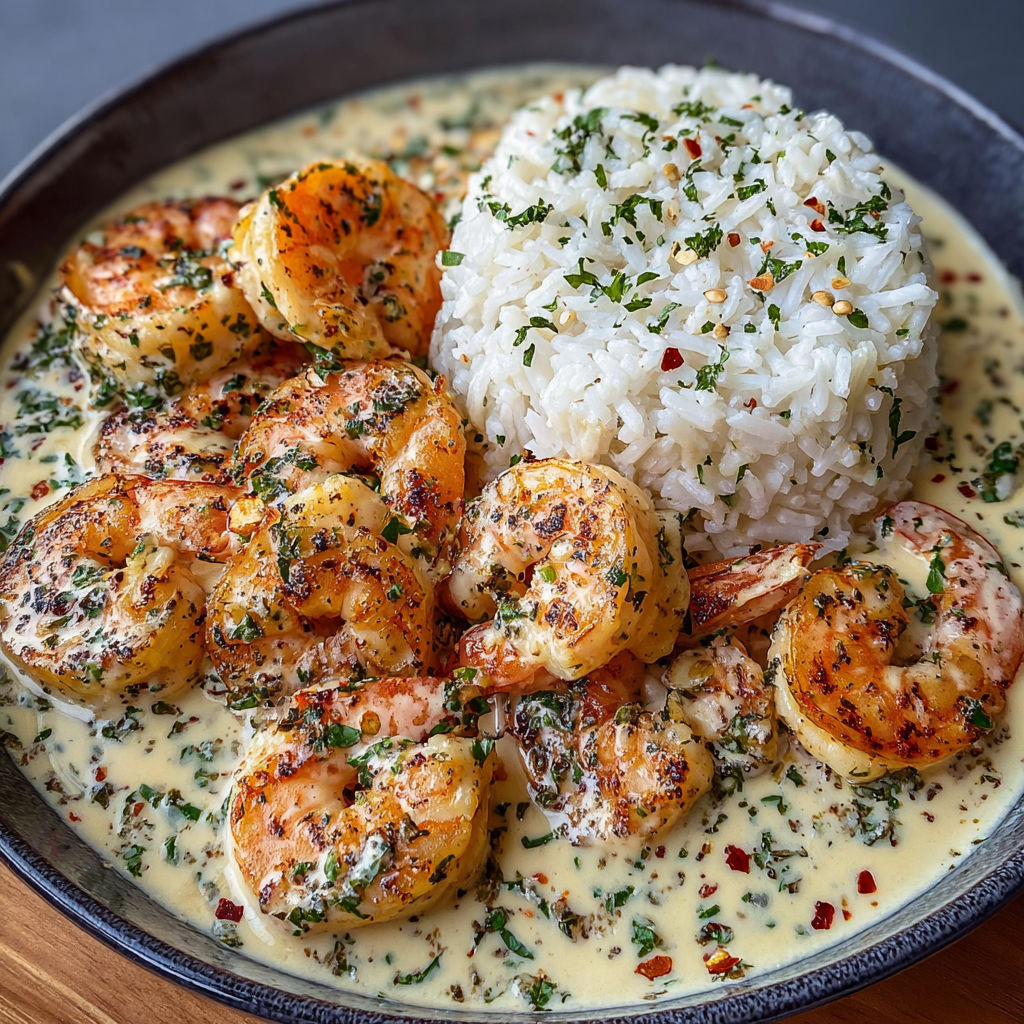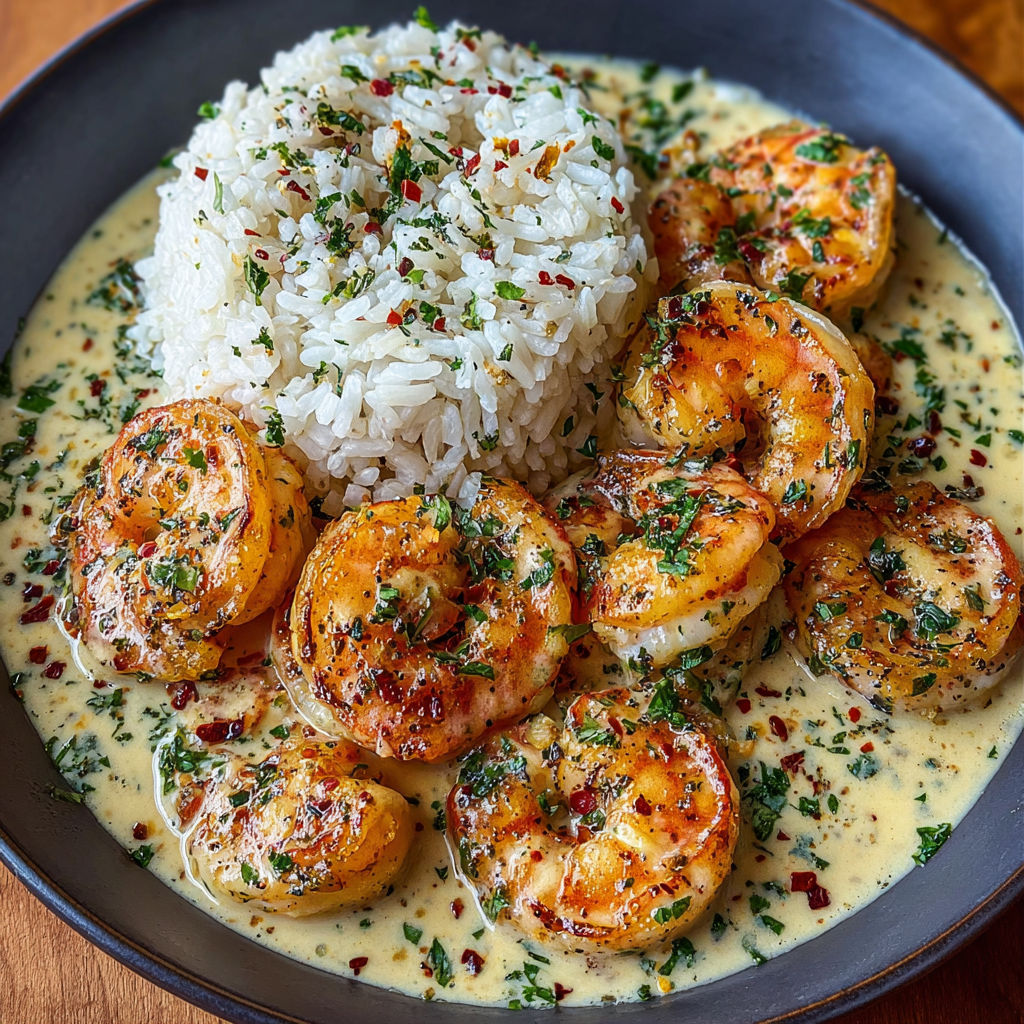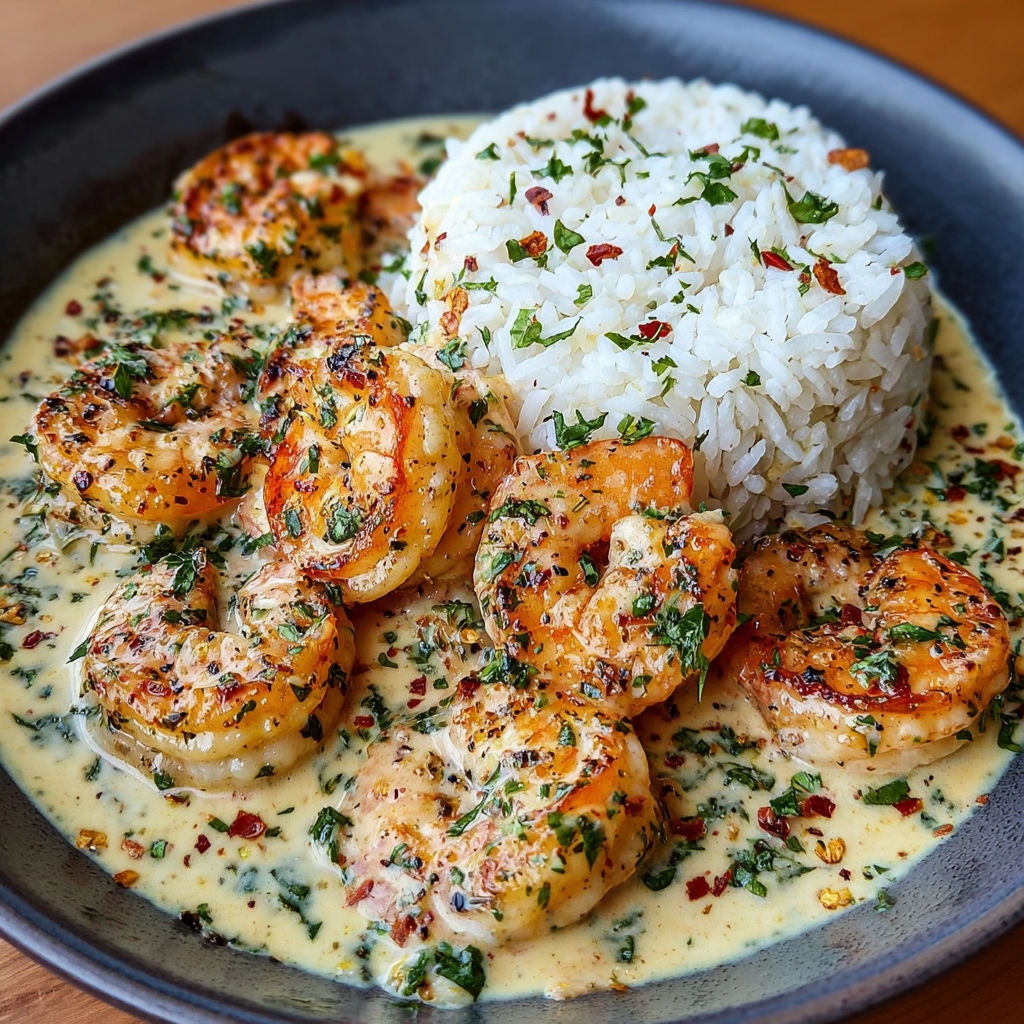 Pin it
Pin it
This creamy garlic butter shrimp bowl with herb rice pulls out all the stops. Plump shrimp seared just right nestle into fluffy rice with fresh parsley and lemon. The sauce is silky from cream and butter, deeply savory with parmesan and a whisper of heat. Honestly, it is comfort food that never feels heavy, just bright and welcoming.
The first time I whipped this up was after a long Monday when I needed something both cozy and quick. My husband could not believe how good the kitchen smelled and now it gets requested on chilly evenings when we want some warmth at the table.
Ingredients
- Low-sodium chicken broth or water: for the rice makes it fluffier and gently seasoned while broth brings richer flavor so choose based on preference or what you have on hand
- Long-grain white rice or jasmine: for delicate aroma and perfect texture pick jasmine for a subtle floral touch
- Salt: for seasoning the rice and shrimp use fine sea salt for better control
- Unsalted butter: enhances richness use quality butter for best taste
- Fresh parsley, chopped: adds herbaceous lift go for flat-leaf if possible for brighter flavor
- Lemon zest: from a fresh lemon so always use unwaxed if possible for brightness
- Large shrimp, peeled and deveined: look for firm moist shrimp with a clean ocean scent
- Olive oil: for cooking shrimp adds subtle flavor go with extra virgin for aroma
- Freshly cracked black pepper: balances lemon and garlic freshly ground makes a difference
- Garlic cloves, minced: for intense aromatics always mince right before cooking for most pungency
- Red pepper flakes: bring gentle necessary heat if desired use fresh or high-quality flakes for the best kick
- Heavy cream or half-and-half: gives silkiness choose cream for pure richness or half-and-half for a lighter sauce
- Parmesan cheese, grated: adds big umami and thickens sauce use real Parmigiano-Reggiano if possible
- Fresh lemon juice: sharpens flavors and brightens always squeeze it fresh for the best zing
Instructions
- Cook Herb Rice:
- Place the chosen broth rice salt and butter into a saucepan and bring to a full boil. Lower the heat and keep covered so the rice absorbs liquid slowly for tenderness. Check after 15 minutes but do not stir. Once done fluff gently then mix in parsley and lemon zest to release their aromatic oils. Replace the lid so the flavors stay vibrant and rice stays warm.
- Season Shrimp:
- Lay shrimp on a clean kitchen towel and pat thoroughly dry. Lay them flat and lightly sprinkle salt and pepper on both sides so seasoning reaches every bite and encourages caramelization in the skillet.
- Sear Shrimp:
- Pour olive oil into a wide skillet and set over medium-high heat until just shimmering. Lay shrimp in one flat layer and avoid crowding so they sear not steam. After about two minutes flip when they turn just opaque. Remove to a plate just as soon as both sides are seared and flesh is mostly pink not curled tight.
- Build Garlic Butter Sauce:
- Turn heat down to medium and drop butter straight into the pan so it foams. Add minced garlic and red pepper flakes if using and stir gently for only thirty seconds. Pour in cream then whisk while scraping flavorful bits from the skillet bottom. Sprinkle in parmesan and stir until melted and the sauce thickens just enough to coat a spoon usually about two minutes.
- Finish Shrimp:
- Tumble the shrimp and any juices back into the creamy sauce. Use a wide spoon to coat every shrimp in the garlicky mixture. Remove from heat right before shrimp are firm so they stay tender. Add lemon juice parsley and adjust seasoning adding more salt pepper or a squeeze of lemon as your taste buds demand.
- Build the Bowls:
- Fluff the rice one more time and divide into bowls for a fresh base. Layer shrimp and spoon creamy sauce over the rice for maximum flavor. Sprinkle extra parsley and serve with bright lemon wedges. Eat while warm to enjoy the contrast between the buttery shrimp and herby citrus rice.
 Pin it
Pin it
I absolutely love how the lemon zest brings lightness to every bite which always reminds me of my grandmothers summer lunches. She showed me how lemon can magically wake up almost any savory dish and that is the secret spark in this bowl.
Storage tips
Store leftovers in an airtight container in the fridge for up to two days. Rice and shrimp do best when reheated gently either on the stove with a splash of water or in the microwave on half power. For freezing make just the herbed rice since shrimp loses its tender texture after freezing.
Ingredient substitutions
You can use basmati rice for a longer grain and mild aroma or swap parsley for fresh cilantro if that is what you have. If you are not a fan of cream sub in coconut milk for a totally different but delicious flavor and a dairy-free option.
Serving suggestions
Serve with a fresh green salad with a tangy vinaigrette or roasted asparagus to keep things light. This dish always shines with extra lemon wedges and more fresh herbs sprinkled over the top. For more crunch add toasted pine nuts or crispy shallots.
Cultural context
Shrimp and rice bowls like this are inspired by Mediterranean coastal cooking where fresh herbs citrus and seafood are everyday fare. The simplicity and versatility come from a tradition of making satisfying meals from easy-to-find ingredients and letting those flavors really shine.
 Pin it
Pin it
This dish brings whole family comfort and makes any evening feel warm and special. Enjoy every bite while it is fresh and creamy for the best experience.
Frequently Asked Questions
- → How do you prevent shrimp from overcooking?
Sear shrimp quickly, about 2 minutes per side, until just pink. Overcooking risks a rubbery texture.
- → Can you use jasmine rice instead of long-grain white rice?
Yes, jasmine rice adds a lovely aroma and complements the herbs and lemon.
- → What can I substitute for heavy cream?
Half-and-half or a splash of milk will lighten the sauce, though it may be less rich.
- → Is Parmesan cheese necessary in the sauce?
Parmesan adds umami depth but can be omitted or replaced with similar hard cheeses.
- → How do you keep herb rice fluffy?
Let rice rest after cooking, then fluff gently with a fork. This helps separate the grains.
